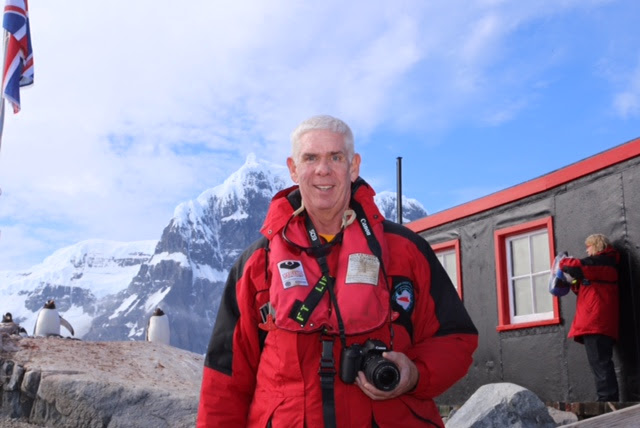Ship's Log: Port Lockroy, nestled on Goudier Island in a sheltered cove off Wiencke Island in the Palmer Archipelago, is the most regularly visited tourist location in Antarctica. It was named by the French explorer, Charcot, for the French Politician, Edouard Lockroy, who helped Charcot to get government support for his expedition.
We went ashore in our small groups so as to not overcrowd the small island, museum andAntarctic Shopping Mall. Each group was given one hour ashore, which was ample time to visit Bransfield House and enjoy the Gentoo Penguins that nest among the dwellings.
Yes, the smell was a little overwhelming at first but you gradually got use to it.
Ship's Log: Port Lockroy 64⁰ 49’S 63⁰ 30’W was established in 1944 by the British in part to report on enemy submarine activity (of which there was none) and to provide weather reports. After the war, it
continued as a scientific base under the auspices of British Antarctic Survey (BAS). A few years later
BAS relocated their science work to Faraday Base and, as a result, Port Lockroy closed in 1962, with
the buildings falling into disrepair. It was renovated by the UK Antarctic Heritage Trust in 1996 and
was designated as Historical Site and Monument 61 under the Antarctic Treaty.
The large glacier located behind the outpost is where we would hike to the top from the other side later today at Damoy Point. The surrounding landscape provided a majestic location for the base.
The gift shop and museum was a popular place to visit. Yes, there was a store where you could purchase items in Antarctica.
The museum had some interesting items and information about the history of the base and what it was like to live there for short periods of time.
The kitchen was well stocked. They had to bring enough supplies for several months as there is no grocery store nearby.
Communications via radio was vital for their survival.
The bunk room was basic and held personal items of the men stationed there.
Ship's Log: As well as running the gift shop and maintaining the museum, one of the other projects undertaken by the Port Lockroy team is surveying the penguins which breed on the island. It appears that the penguins visited by tourists enjoy somewhat higher breeding success than those outside the tourist-visited parts of the island. While the reasons for this are not fully understood, it is thought this is probably because the presence of humans interferes with egg and chick predation by Brown Skuas. Before concluding that tourists have a positive effect, however, it is also important to consider our effect on the entire ecosystem and not just an individual area.
continued as a scientific base under the auspices of British Antarctic Survey (BAS). A few years later
BAS relocated their science work to Faraday Base and, as a result, Port Lockroy closed in 1962, with
the buildings falling into disrepair. It was renovated by the UK Antarctic Heritage Trust in 1996 and
was designated as Historical Site and Monument 61 under the Antarctic Treaty.
The large glacier located behind the outpost is where we would hike to the top from the other side later today at Damoy Point. The surrounding landscape provided a majestic location for the base.
The gift shop and museum was a popular place to visit. Yes, there was a store where you could purchase items in Antarctica.
The museum had some interesting items and information about the history of the base and what it was like to live there for short periods of time.
The kitchen was well stocked. They had to bring enough supplies for several months as there is no grocery store nearby.
Communications via radio was vital for their survival.
The bunk room was basic and held personal items of the men stationed there.
Ship's Log: As well as running the gift shop and maintaining the museum, one of the other projects undertaken by the Port Lockroy team is surveying the penguins which breed on the island. It appears that the penguins visited by tourists enjoy somewhat higher breeding success than those outside the tourist-visited parts of the island. While the reasons for this are not fully understood, it is thought this is probably because the presence of humans interferes with egg and chick predation by Brown Skuas. Before concluding that tourists have a positive effect, however, it is also important to consider our effect on the entire ecosystem and not just an individual area.
Ship's Log: Antarctic Cormorants
were seen flying between their colonies on nearby Jougla Point. Although cormorants live
worldwide, the Antarctic Cormorant, which is also known as the Blue-eyed Shag, is the only
cormorant species breeding around the Antarctic Peninsula, although it can also be found in the
South Shetland Islands and on Elephant Island. The world population is believed to be only
about 11,000 pairs.































No comments:
Post a Comment